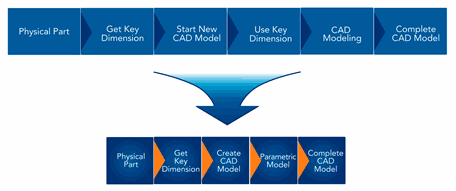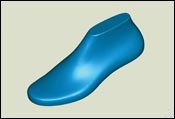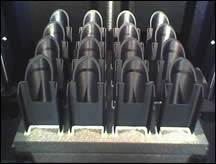DSSP: The Catalyst for a New Revolution
One CAD short- coming—a frequent disconnect between the final manufactured product and the idealized CAD model—is being addressed with digital shape sampling and processing.
When 3-D solid modeling burst on the scene about 25 years ago, it promised a new era of enlightenment, where manufacturers could create digital models that accurately represent their products and use those models throughout the product development process. As time rolled on, designers and engineers fulfilled much of the vast potential of CAD, while also becoming aware of its shortcomings.
One of those shortcomings is a frequent disconnect between the final manufactured product and the idealized CAD model. Over the last decade, that gap has been filled by technologies categorized as digital shape sampling and processing (DSSP).
Digital Shape Sampling and Processing
DSSP encompasses multiple advances in 3-D scanning technologies. It describes the ability to use scanning hardware and processing software to digitally capture physical objects and automatically create accurate 3-D models for design, engineering, inspection and custom manufacturing.
DSSP acts as a complement to CAD by aligning the physical and digital worlds, ensuring that the design model is an accurate representation of the as-built product. This alignment is frequently missing in CAD, where the digital model is often an idealized version of the physical product.
Accurate alignment between the digital representation and as-built product delivers major benefits, including:
- Time and money savings due to faster development cycles and design iterations.
- Better quality through more accurate engineering analysis, resulting in less manufacturing waste, lower rework costs, and reduced product returns and recalls.
- The ability to customize products in mass quantities, creating competitive advantage and distinctive product branding.
- Automated quality inspections that reduce labor costs and staffing requirements.
- Replacement of tedious, manual jobs with automated processes, providing more control, less reliance on outsourcing, and greater employee safety and satisfaction.
DSSP adds value at both the front and back end of the product development lifecycle. At the front end, it is used for concept design. At the back end, it ensures that what’s been produced conforms to design specifications.
In a 2008 study, the Aberdeen Group looked at how companies were using digital prototyping to meet product revenue targets, including cost, quality, launch dates and development cost. The study found that the most successful companies, the top 20 percent, are 2.7 times more likely to use DSSP in their product lifecycles.
Automation Drives Adoption
Like any fast-evolving technology category, DSSP is a moving target, but some major trends are evident.
One of the most important is continued automation and ease of use. Gaps and noise in scanning data that used to take days to resolve are now corrected automatically in the best DSSP software. Conversion to polygons and NURBS surfaces, once requiring days of tedious work, can now be handled in minutes using a natural, intuitive workflow.
Increased ease of use and automation has spread the value of DSSP beyond specialists and R&D labs into the mainstream design, engineering and quality inspection departments in every manufacturing industry, especially auto-
motive, aerospace, consumer products and medical.
Better and Faster Processing
Hardware that is integral to DSSP continues to adhere to the precepts of Moore’s Law, getting better, faster and cheaper. This movement is enabling more companies to come to the DSSP table.
On the front end, scanners have become more portable, flexible and accurate, even as prices continue to drop. Computers used for data processing are giving designers and engineers desktop power that is the equivalent of a supercomputer from 10 years ago. Point-cloud data that would choke a high-end computing system five years ago is now easily digested by modern PCs.
At the back end of the product development process, a new generation of rapid prototyping and manufacturing systems are making their mark, expanding the options for producing customized molds and end products. These systems are already playing a major role in customized manufacturing of dental and hearing appliances, and will be seen in a wide range of evolving DSSP applications in the future.
Software: The Game Changer
Software can be thought of as the quarterback in DSSP, getting all of the elements to work as a concerted team. At its best, software moves the project seamlessly downfield from scanning to processing on the computer to CAD systems that prepare the model for engineering analysis, moldmaking, tooling, milling and manufacturing.
As the most valuable player on the team, software can play a profound role in changing the DSSP game. A recent software innovation—the ability to extract design intent from scans of a physical product—is a prime example of this game-changing effect. Quite simply, this new method provides the fastest path from design conception to a completed digital model ready for manufacturing.
The ability to extract design intent from a physical product gives industrial designers something they’ve never had before—an easy and fast way to convert classic designs into new, endless variations. Imagine thousands of models of classic Nike shoes or personalized gas tanks for Harley-Davidson motorcycles or new Fiskars scissors customized to fit exactly to your hand.
Application Proliferation
Innovation almost always leads to a wealth of creative applications—think of the application explosion that has accompanied the latest iPhone. As individuals and companies have become more aware of what DSSP can do for them, they have invented new ways to apply it. In some cases this has been driven by specialized software modules for tasks such as turbine blade inspection. In others, it comes from developer’s toolkits for specific applications such as dental CAD/CAM. But, most of all, it comes from users who find innovative ways to apply new technologies.
This year at a user conference a wide range of organizations demonstrated the breadth and impact of DSSP applications:
- ITT Goulds Pumps has developed revolutionary processes for determining variances among sand molds, castings and as-manufactured impellers, leading to greater quality and cutting months off of project time.
- NYU uses DSSP as both a measurement tool for breast reconstruction and as a valuable aftercare tool that quantifies surgical results and tracks changes over time, enabling better initial treatment and long-term assessment of results.
- Shriners Hospital has developed a cleft lip and palate treatment that allows the cleft and skull to continue growing, avoiding the flattened face that often resulted from previous methods and minimizing the need for additional surgery.
- Ford pioneered a way to simulate manufacturing using models of as-built assemblies in a virtual environment, saving millions of dollars in physical testing.
- Aerospace maintenance and repair organizations (MROs) migrated from using DSSP as a digital reconstruction tool to making it a central component in their strategies to more efficiently manage products throughout their entire lifespan.
Convergence for a New Age
Over the last few years, there has been a backlash against the disposable culture, led by a combination of environmental concerns and a renewed appreciation for functional, reliable and good-looking products. Elegant simplicity has become a major asset. Instead of crowding landfills, we want to pass along that mixer or vacuum cleaner or sewing machine to our daughter.
There is an increased realization that design and function of the goods we use and the clothes we wear say something about us, and can make us feel good. The more personalized, the better. Beyond consumerism, the ability to make things that precisely fit the human body has tremendous implications in medical treatment.
DSSP is underlying this convergence of design and quality, and will be the catalyst in making it a mass movement. Most organizations that use DSSP for design also are using it for quality assurance—not just inspection, but also engineering analysis that enables testing in a virtual environment where the as-built model and the CAD representation are assembled together before any physical product, assembly or factory production line is built.
Companies also are seeing the potential to use scans of an existing product as the basis for endless variations that can be produced economically in small batches.
DSSP is far from a household acronym, but in its ability to radically transform the way we design and engineer products, it is the hidden force behind a modern manufacturing revolution.
Related Content
How to Manage Wall Thickness Changes in Your Mold Design
To ensure even filling and cooling, consider wall section transitions, corners and fillets, ribs and bosses, lip and rim designs and CAE flow simulation software.
Read MoreHow to Select a Mold Temperature Controller
White paper shares how cooling channel analysis, which collects maximum pressure drop, total flow rate and heat dissipation, eases the performance evaluation of mold temperature controllers.
Read MoreFour Micro Tooling Considerations
Issues involving gating, ejection, mold splits and direction of pull are of special concern when it comes to micro tooling.
Read MoreWhat Is Scientific Maintenance? Part 1
Part one of this three-part series explains how to create a scientific maintenance plan based on a toolroom’s current data collection and usage.
Read MoreRead Next
Thought to Part: Rapid Manufacturing
An example where rapid product development and direct digital manufacturing can work.
Read MoreAre You a Moldmaker Considering 3D Printing? Consider the 3D Printing Workshop at NPE2024
Presentations will cover 3D printing for mold tooling, material innovation, product development, bridge production and full-scale, high-volume additive manufacturing.
Read MoreHow to Use Continuing Education to Remain Competitive in Moldmaking
Continued training helps moldmakers make tooling decisions and properly use the latest cutting tool to efficiently machine high-quality molds.
Read More


























